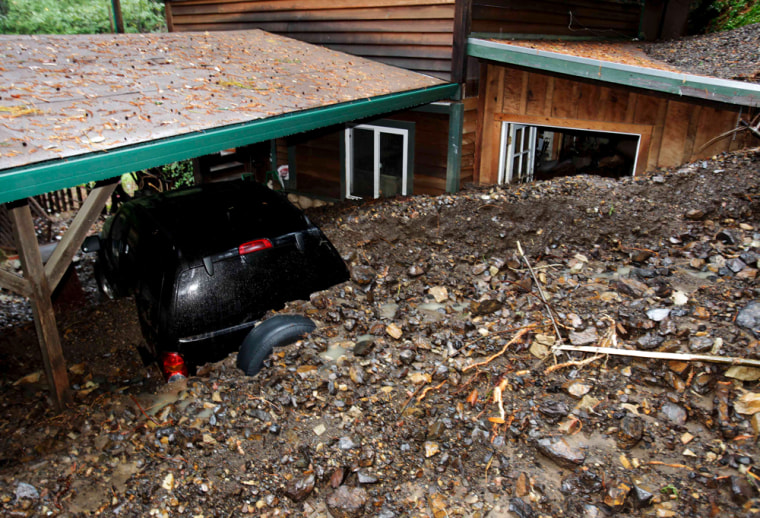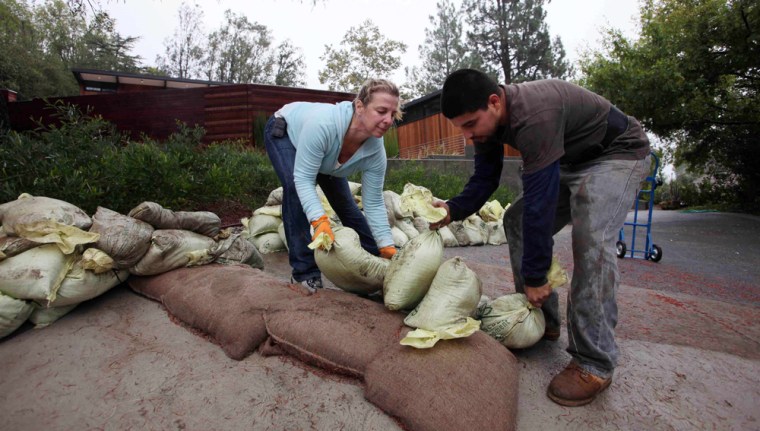Nervous hillside residents across California woke up to find that a storm had not triggered major mudslides overnight, but the system did cause a chaotic morning commute in Los Angeles a day after doing the same in the San Francisco and Sacramento areas.
The National Weather Service canceled its flash flood advisory for Los Angeles County shortly before dawn Wednesday, as the rains that drenched the region overnight began easing up.
But the morning commute was a mess. In the Los Angeles area, jackknifed big-rigs and spun-out vehicles littered freeways as hubcap-deep pools caused by overwhelmed storm drains kept travel lanes impassable.
The California Highway Patrol reported 186 traffic accidents in Los Angeles County during the six-hour period ending at 6 a.m. — compared with 19 crashes during the same period a week ago.
The storm on Tuesday slammed into a drought-stricken state that has become a checkerboard of wildfire scars. Flash flood watches were posted for burn areas dating back to early 2008, and 800,000 homes and businesses lost power at the height of the storm.
In San Francisco and Sacramento, the storm on Tuesday caused commuting chaos as well as flight delays.
A mandatory evacuation order remained in effect for residents of about 40 homes in central coast mountains near Watsonville, east of Monterey Bay, due to mudslides, said Chris Hirsch, a spokeswoman for Santa Cruz County emergency services. A dozen other homes were isolated because fallen trees and debris blocked roads.
"We can't get in, they can't get out," Hirsch said.
Less rain than expected in L.A.
The storm lost momentum by the time it reached Southern California, where up to 5 inches of rain had been forecast.
"This strong system sort of just rained itself out over Central California and as it moved down lower it had already started to exhaust itself slightly," said Jamie Stern, a National Weather Service spokeswoman. "As it moved on downward we didn't get the full effect of what the storm originally was."
Hillsides made bare from summer fires had raised the fear of mudslides and debris flow.
Many parts of the state remained under flash flood watches, meaning conditions were favorable for flooding.
Two inches of rain had fallen by midmorning in La Canada-Flintridge, one of a string of Los Angeles suburbs on the foothills of the San Gabriel Mountains, where the Station Fire burned 250 square miles this summer.
Residents began breathing easier as drizzle fell on the foothill suburbs, but it continued to rain harder at higher elevations.
"From our standpoint, we're in pretty good shape, unless we have a huge increase in rain," said retired geologist Jim Conel outside his home near a damp hillside blackened by the flames. "Thank the Lord, or whoever: it's OK."
Crews continued to put concrete barriers and sandbags in place in communities to contain potential debris flows and direct them away from properties.
Northwest of Los Angeles, Santa Barbara County resident Cherie Topper could see little flow in a creek running through her San Roque Canyon property within the steep Santa Ynez Mountains, close to where a wildfire early this year burned thousands of acres below.
"It's a warm, very gentle rain," she said. "There doesn't appear to be much in the way of drainage."
Some still without power
About 76,000 Pacific Gas & Electric customers were without power Wednesday, down from 686,000.
The storm damaged 140 poles and more than 102 miles of power lines, PG&E spokesman Joe Molica said.
"This storm was significant, and it really packed a wallop," Molica said.

Residents in rural areas may not have their power restored for a few more days, Molica said.
While the storm brought heavy rainfall to some parts of the state, it did little to boost California's reservoirs in the Northern Sierra, which are the starting point for state and federal water supplies. That's because snow fell higher than 9,000 feet and above the snowpack that feeds the state and federal reservoirs, said Elissa Lynn, a meteorologist at the Department of Water Resources.
"The storms were big deals from a local point, but from a statewide water perspective, it hasn't yet improved things greatly," Lynn said.
Three years of below-normal rainfall and snowfall have left California's major reservoirs with less water than normal. Lake Oroville is about 37 percent full, which is about 60 percent of normal for this time of year.
More on:
